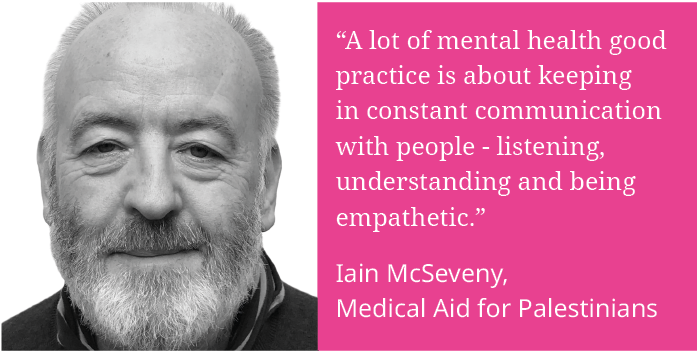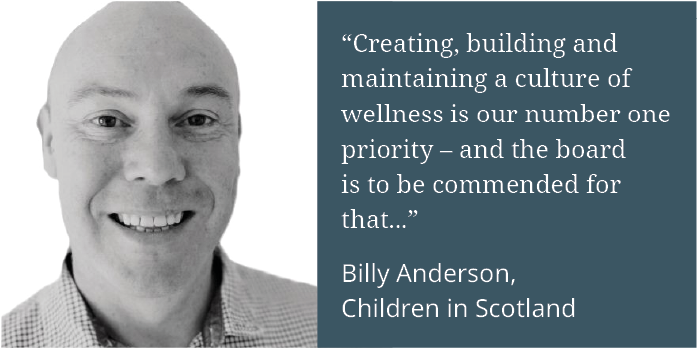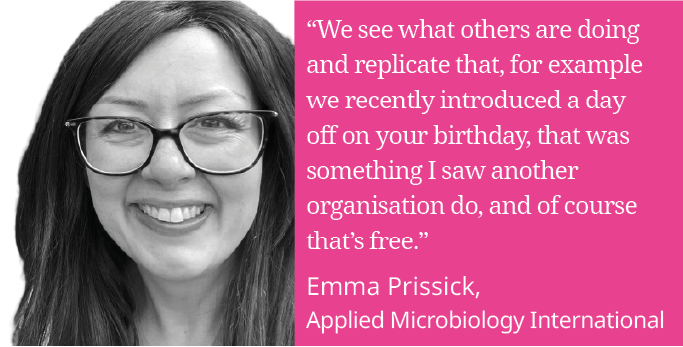For World Mental Health Day on 10 October, Sam Burne James finds out how four different charities are prioritising the wellbeing of their staff and volunteers. Read on to learn from their experiences and insights...

“I’ve been saying for years that ‘employees are our most valuable asset’,” reflects the infamous, ineffectual pointy-haired boss in a memorable edition of Dilbert, the long-running comic strip lampooning corporate nonsense.
“It turns out that I was wrong,” he continues. “Money is our most valuable asset. Employees are ninth.”
The UK charity sector today is in many ways a very different environment to that which gave rise to Dilbert; Silicon Valley in the '80s and '90s. Charity leaders agree that neglecting staff wellbeing is a short-sighted option which undermines organisational resilience, and risks increasing staff turnover, damage to your employer brand, and more. Nonetheless, there is a risk that ‘employees are our greatest asset’ remains soundbite rather than reality.
The VCSE Observatory’s recent report Wellbeing in Voluntary Organisations: The Cost of Doing Good argues that the sector “cares deeply about its workforce but doesn’t always feel equipped to support them”. It notes that while 87% of charities try to foster a culture of respect and inclusion, and 72% consider staff wellbeing a strategic priority, just 37% actively support workload management, and only a little over half (56%) have a specific wellbeing strategy in place. On top of all that, the fact that a reported 12% of people in our sector are paid less than the living wage is hardly conducive to happy teams.
The theme of this year’s World Mental Health Day, which is set by the World Health Organization, is ‘mental health in humanitarian emergencies’ – and it specifically acknowledges the importance of protecting the wellbeing of humanitarian workers themselves, alongside the people directly impacted by such crises.
So how can charities – whether operating in warzones or responding to domestic deprivation, environmental emergencies or other pressing social issues – ensure that they protect their staff’s mental wellbeing?
Charity Finance Group has gathered lessons from four organisations in very different spaces.
Medical Aid for Palestinians: survival and empathy

UK-headquartered charity Medical Aid for Palestinians (MAP) has around 280 staff, half of whom are locals in the West Bank and Gaza.
For those local staff, mental health-specific interventions are important but not their top priority right now, says Chief Operating Officer Iain McSeveny. “It's not just about mental health but about survival and how we can help them get access to food, water, cash, and safe accommodation. There's no 'policy' you can write for a situation like this; it's just about listening to what people need and what can we do to keep people alive,” he says.
"It's absolutely not one-size-fits-all, because it needs to be tailored to an individual and their family needs,” he adds. “A lot of mental health good practice is about keeping in constant communication with people - listening, understanding and being empathetic.”
The situation faced by NGO and aid workers in conflict zones is at the extreme end of the spectrum. Nonetheless, it highlights an important truth. Mental health support per se can only achieve so much if a charity employee’s low wage plus inflationary pressure means they have to use foodbanks; if the temporary nature of their contract means they worry about keeping up with the mortgage; or if they’re at risk of verbal abuse or physical violence in their line of work. It’s Maslow’s hierarchy of needs, in short.
On top of the local staff, McSeveny’s colleagues include around 100 UK-based staff plus smaller numbers in Cairo and Lebanon, some of whom have been in Gaza and the West Bank during the current conflict, returning “traumatised by what they have witnessed” and needing counselling and other support, he adds.
McSeveny has noticed higher levels of office attendance (as opposed to home working) of late. “I think people need that time together,” he says. Given the length of the current conflict and the hugely strained and often toxic public conversations around Palestine and Israel right now, he has also been encouraging colleagues “to take down-time and properly switch off, even though it feels difficult to do so”, but acknowledges that the “very committed” staff often struggle to do so. There is, he adds, almost a “feeling of guilt in sitting in our London office while our colleagues in Palestine are suffering so much”.
Most charities in the UK are fortunate enough not to have to deal with such traumatic circumstances, either in-person or through colleagues - but that’s not to say their staff don’t need support. Whatever your charity does, a good wellbeing policy provides a helpful starting point - albeit that it must be flexible rather than ‘one-size-fits-all’, to empower team leaders and line managers to support staff on an individual basis.
Children in Scotland: reflecting frontline practice

The context may be rather different, but it’s a view echoed by Billy Anderson of Children in Scotland. Anderson’s role as Head of Services, Participation & Policy is external-facing, but he also chairs the cross-department wellbeing group at the charity, which has around 50 staff.
He also previously worked in frontline roles. Having moved into leadership, he says he approaches management “in a similar way to how I worked with young people - I’d apply the same processes, it’s about making space to listen to them, and being person-centred.”
Specifically, Children in Scotland has a wellbeing action plan based around the ‘SHANARRI’ wellbeing indicators which are the bedrock of work across Scotland with children, young people and families. The various measures the charity has instituted include a ‘Watercooler’ channel on its all-staff Teams; a ‘cheeseboard’ allowing colleagues to post positive messages about each other online; and facilitated, confidential ‘tea and talk’ sessions when staff have showed signs of being overwhelmed and demoralised by outside issues such as global conflict.
It uses awareness days like World Mental Health Day to remind people of existing and developing plans in this area, rather than to announce isolated, token gestures. “Creating, building and maintaining a culture of wellness is our number one priority - and the board is to be commended for that, because one of the first things they always ask us is about the team’s wellbeing,” Anderson says.
The charity recently had to go through redundancies, he adds - an important test of its commitment to wellbeing. “We could have made cuts in other areas,” Anderson comments, “but we decided that maintaining our principles in other areas is something we’re not going to compromise on."
That said, he adds a note of caution. “We need wellbeing to be visible and we need our messaging to be repetitive, but not feel like too much… [like] wellbeing is being shoved down their throat,” he says. Communications around wellbeing are always “very carefully worded around choice and control” ensuring colleagues know that they are in charge of how and how often they engage.
Choice and control, as it happens, are another example of external practice reflecting the internal - they are one of the ‘five accomplishments’ at the basis for person-centred approaches in a range of settings.
What elements of your external work could replicate internally? And to what extent do your trustees, who of course ultimately set the tone for the organisation, know and care about your wellbeing approach?
Applied Microbiology International: small but ambitious

The charity Applied Microbiology International (AMI) has 19 staff, including a CEO who “really prioritises staff wellbeing”, in the words of its Director of Finance and Corporate Services Emma Prissick. Among other things, this means that HR and development “is a standing monthly item on the agenda for SLT meetings, ensuring that we review it regularly”.
As well as offering a four-day week as standard - something being trialled by a number of other charities, and in other sectors - AMI replicates internally what it offers externally by giving its staff a subscription to popular mental health app Headspace. This is also offered to its scientist members.
AMI is “very proud” to have been in The Times' Best Places to Work lists in both 2024 and 2025, says Prissick. It should be - it is one of just five non-profits in the ‘small organisation’ section of the list - with the ‘big’ and ‘medium’ lists also having five apiece.
“I also use the list for inspiration,” she adds. “We see what others are doing and replicate that, for example we recently introduced a day off on your birthday, that was something I saw another organisation do, and of course that's free.” The charity also offers all staff the chance to train as Mental Health First Aiders, and around a quarter have done so, Prissick says.
Taking inspiration from peers, and thinking about free or low-cost benefits, are two further tips for getting your wellbeing and mental health support in order. While Prissick is realistic about the challenges of balancing aspiration with budget, she also urges smaller charities to embrace the advantages of their size.
“There are some drawbacks to being smaller, but there are also advantages - I’m not sure it’s a case of being harder or easier to get this right in a larger or smaller organisation, it’s just different challenges,” she says.
“Perhaps in larger organisations or different sectors you’re able to dedicate significant budget to wellbeing, but in a smaller organisation we can genuinely involve everyone in decision-making, we can implement things quickly, and get the feedback by sitting down with every single person, things that just aren’t possible in a much bigger organisation.”
RNLI: invest and measure

RNLI crews in rough weather. Source: RNLI
From a smaller charity, to one of the UK’s most prominent: Adam Dixon is mental health and wellbeing lead at the RNLI.
“We view investment in mental health and wellbeing as essential to delivering our lifesaving mission, not separate from it,” he comments. “By investing in wellbeing, we aim to have a direct impact on operational effectiveness, retention and safety – which ultimately protects both our people and the communities we serve.”
The RNLI has a specific FL-AIR (Framework for Lifesaving – Achieving Individual Resilience) strategy for operational staff and volunteers. This includes both tools preparing individuals for witnessing or being part of traumatic events, as well as post-event risk assessments to identify those who may need extra support.
One element of this, its Trauma at Sea Impact Prevention training, was piloted at 20 stations during 2024/25, and independent evaluation showed a “significant increase” in participants’ “confidence and ability to process traumatic incidents”.
The RNLI’s wider mental health and wellbeing strategy is currently “in development”, Dixon says, but the organisation is already well attuned to the impact on its people of external attacks, criticism and being dragged into the culture wars.
“Our people can sometimes face difficult questions or confrontation linked to some elements of our lifesaving work,” Dixon puts diplomatically. “To support them, we provide regular communications, workshops and guidance. This helps volunteers and staff feel confident in how to respond – whether that means engaging constructively with dialogue, feeling empowered to step away from confrontation, or signposting to further information. We want everyone to know they are backed by the organisation, and that their wellbeing comes first.”
If the charity you work for is at risk of being drawn into difficult debates – whether on vaccine scepticism, geopolitics, gender identity or anything else – would you and your colleagues feel the same?
While it has been forced into a prominent position in the culture wars, it has actively put itself ahead of the curve in another area. Dixon and his team “continually measure effectiveness through evaluation of training, feedback from volunteers and staff, and data on uptake of services”, he says.
Meanwhile, the aforementioned VCSE Observatory report says that just 25% of charities measure staff wellbeing, a figure falling to 15% for volunteers.
That mismatch of organisations being more likely to take action around staff wellbeing than that of volunteers is seen through the report. Elsewhere, and this is just one of several examples, it notes that 60% of organisations provide employees with some access to mental health support, but just 33% provide this to volunteers.
With charities finding volunteers harder to find, ensuring that both paid and unpaid colleagues’ wellbeing is supported should be high on the sector’s agenda. So should measuring the impact of this activity with the same rigour as external work.
Starting points
Taken together, these examples provide a number of pointers for charities wanting to enhance or begin their wellbeing offer. The key lessons from them can be summarised as such:
- Don’t forget the basic needs of teams operating in a crisis situation or warzone
- Create space to listen, understand and be empathetic
- Ensure that line managers are empowered by policies, rather than constrained by them
- Bring the outside in – consider what elements of your external work could be replicated or inspire internal practice, and take inspiration from peer organisations
- Prepare your staff to respond to external criticism – or to ignore it
- Measure what you’re doing and the impact it has
- Ensure your wellbeing practices cater for volunteers as well as paid staff
If you’re wondering where to start, the VCSE Observatory report includes a number of helpful resources, including:
Wellbeing is also a frequent conversation in CFG’s Special Interest Groups – all members can join these groups. Find out more and get involved!